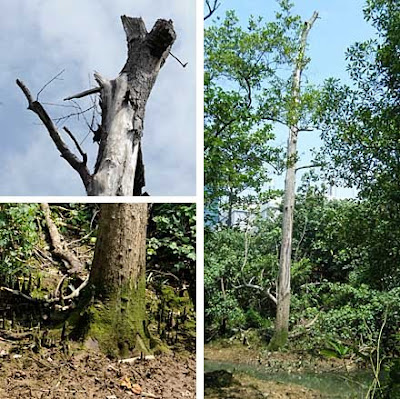 Thanks to Dr John Yong who confirmed that the tree I saw during a previous visit was a Sonneratia caseolaris. I eventually learnt that there were actually three trees at Woodlands Park. Today I thought I should have a look for the other two.
Thanks to Dr John Yong who confirmed that the tree I saw during a previous visit was a Sonneratia caseolaris. I eventually learnt that there were actually three trees at Woodlands Park. Today I thought I should have a look for the other two.What are the signs of a Sonneratia?
Big conical pneumatophores are a good clue.
 Aha, the gianormous tree opposite this little stream seems to be a Sonneratia.
Aha, the gianormous tree opposite this little stream seems to be a Sonneratia.The tree is so huge and spreading that bits of it are falling on the side of the stream where I'm at.
 There are tiny white bits that look like beansprouts, and way out in the soft mud which I can't reach, a fallen flower which looks like those of Sonneratia caseolaris.
There are tiny white bits that look like beansprouts, and way out in the soft mud which I can't reach, a fallen flower which looks like those of Sonneratia caseolaris.The leaf shape and arrangement is also a good clue, but hard to see as the tree is so tall and there are many other tall trees in the way.
 To me, I feel, the leaves of Sonneratia caseolaris are more elegant. Arranged more neatly than in a Sonneratia alba where the leaves are more messy. Sigh. That wasn't very scientific I'm afraid.
To me, I feel, the leaves of Sonneratia caseolaris are more elegant. Arranged more neatly than in a Sonneratia alba where the leaves are more messy. Sigh. That wasn't very scientific I'm afraid.A little further along, on the same side of the stream as the big healthy tree, was a big dead one.
 The remains of conical pneumatophores suggests it might have been a Sonneratia. It was really tall, and really dead. Oh dear.
The remains of conical pneumatophores suggests it might have been a Sonneratia. It was really tall, and really dead. Oh dear.The mangroves are so narrow that you can see a little of it from the busy road full of roaring trailer trucks and heavy vehicles bearing down from the Causeway.
 I walked along the road and got another view of the big healthy Sonneratia caseolaris.
I walked along the road and got another view of the big healthy Sonneratia caseolaris.A little further along, I had a look at the Sonneratia caseolaris I saw on my previous trip.
 Aha! It was flowering. The tree was really tall so it's still hard to take a close look. But on the road, I was at least 6m above root level so I was a little closer.
Aha! It was flowering. The tree was really tall so it's still hard to take a close look. But on the road, I was at least 6m above root level so I was a little closer. It sure looks like Sonneratia caseolaris with the red petals!
It sure looks like Sonneratia caseolaris with the red petals!The mangroves of Woodlands Park has some great flora! Besides the two magnificently huge Sonneratia caseolaris which are listed as 'Critically Endangered' in the Red Data Book, I also checked up on the 'Endangered' Brownlowia tersa that is found here.
 I didn't really look at the animals as I was constantly looking up at the tall trees. But I did notice some mounds. Are they mudlobster mounds? There were also lots of little growing mangrove seedlings on the ground.
I didn't really look at the animals as I was constantly looking up at the tall trees. But I did notice some mounds. Are they mudlobster mounds? There were also lots of little growing mangrove seedlings on the ground.Woodlands mangroves are in a very narrow strip, and parts are canalised.
 I also came across a well trampled path to a well trampled area in the mangroves equipped with tarpulin shelters. As I was heading home, I noticed a group of young men heading to the area.
I also came across a well trampled path to a well trampled area in the mangroves equipped with tarpulin shelters. As I was heading home, I noticed a group of young men heading to the area.Let's hope this precious strip of mangroves continues to thrive.
References
- Ng, Peter K. L. & N. Sivasothi, 1999. A Guide to the Mangroves of Singapore I (Plant Diversity). Singapore Science Centre. 168 pp.
- Davison, G.W. H. and P. K. L. Ng and Ho Hua Chew, 2008. The Singapore Red Data Book: Threatened plants and animals of Singapore. Nature Society (Singapore). 285 pp.
